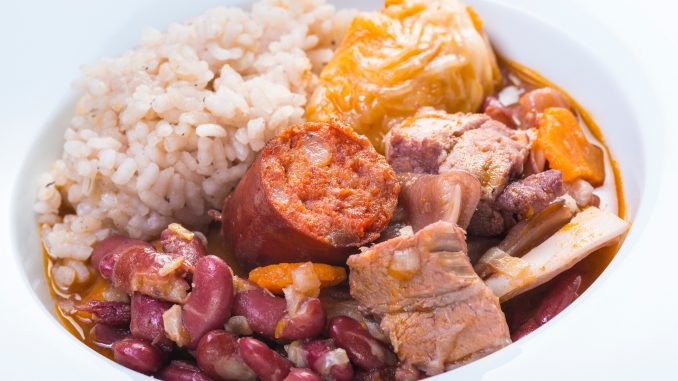
In the northeastern highlands of Portugal, nestled within the rugged and picturesque region of Trás-os-Montes, a culinary masterpiece comes to life on dining tables and in family kitchens. This iconic dish, known as Feijoada à Transmontana, is a symphony of flavors that reflects the rich culinary heritage of the area, combining humble ingredients with centuries-old tradition to create a gastronomic experience that is both hearty and deeply satisfying.
Historical Roots and Cultural Significance
The roots of Feijoada à Transmontana can be traced back to the agrarian traditions of Trás-os-Montes, where rural communities relied on locally sourced ingredients to create nourishing and flavorful meals. As a testament to the resourcefulness of the people in this region, feijoada emerged as a culinary marvel that transformed simple ingredients into a dish that transcends its humble origins.
Culturally, Feijoada à Transmontana holds a special place in the hearts of the people of Trás-os-Montes. It is more than just a meal; it is a representation of community, family, and a connection to the land. The dish often takes center stage during festive occasions, family gatherings, and traditional celebrations, bringing people together to share in its warmth and richness.
Ingredients and Preparation
At the heart of Feijoada à Transmontana is the harmonious blend of ingredients, each contributing to the depth and complexity of flavors. While variations exist, the traditional recipe typically includes black beans, a variety of pork cuts, and aromatic spices. The star of the show, however, is the Linguiça de Chouriço, a distinctive Portuguese sausage that hails from the Beira region and imparts a smoky and flavorful essence to the dish.
The careful preparation of Feijoada à Transmontana involves layering flavors through a slow-cooking process. The beans are simmered to perfection, absorbing the essence of the meats and spices, creating a robust and savory broth. The meats, which may include pork ribs, chorizo, morcela (blood sausage), and other cuts, are added at strategic points during the cooking process, allowing their flavors to meld and infuse the dish with a rich tapestry of tastes.
What sets Feijoada à Transmontana apart is the use of the iconic Linguiça de Chouriço. This sausage, often vibrant red from the generous use of paprika, is a key ingredient that elevates the dish to new heights. The Linguiça de Chouriço‘s smoky and slightly spicy profile adds a distinctive character that lingers on the palate, making each bite a memorable experience.
The Culinary Symphony: A Tasting Experience
Feijoada à Transmontana is more than a meal; it is a sensory journey that engages the taste buds, olfactory senses, and even the eyes. The dish is a visual feast, with the deep, dark hues of the beans contrasting with the vibrant reds of the Linguiça de Chouriço and the various pork cuts. The aromas that waft from the pot during the slow-cooking process are an invitation to savor the impending flavor symphony.
As one takes the first spoonful, the robust broth, infused with the essence of the meats and spices, envelops the palate. The black beans, tender and flavorful, offer a textural contrast, providing a canvas for the richness of the pork cuts. The Linguiça de Chouriço, with its smoky undertones, imparts a depth that lingers, creating a symphony of tastes that dance on the taste buds.
Feijoada à Transmontana is often served with traditional accompaniments such as rice and greens, providing a balance to the hearty and savory nature of the dish. The combination of these elements creates a harmonious meal that satisfies not only the hunger but also the soul.
Cultural Continuity and Adaptations
As with many traditional dishes, Feijoada à Transmontana has adapted to changing times while maintaining its core essence. In modern kitchens, chefs and home cooks alike may introduce subtle variations to the recipe, experimenting with ingredients or preparation techniques. However, the spirit of Feijoada à Transmontana remains intact—a celebration of local flavors, a testament to culinary ingenuity, and a link to the cultural roots of Trás-os-Montes.
In the broader culinary landscape, Feijoada à Transmontana has also transcended regional boundaries. As Portuguese communities have dispersed around the world, this iconic dish has found a place on tables in Brazil, the United States, and beyond, becoming a symbol of Portuguese gastronomy and a cherished connection to the homeland.
Recipe
Serves 6
Ingredients
- 1 pound (about 450g) black beans, dried
- 1 pound (about 450g) Linguiça de Chouriço (Portuguese smoked sausage)
- 1 pound (about 450g) pork ribs
- 1 pound (about 450g) pork shoulder, cut into chunks
- 1 pound (about 450g) morcela (Portuguese blood sausage), optional
- 1 large onion, finely chopped
- 4 cloves of garlic, minced
- 2 bay leaves
- 1 tablespoon sweet paprika
- 1 teaspoon smoked paprika
- 1/2 teaspoon ground cumin
- Salt and pepper to taste
- Olive oil
- Fresh parsley, chopped, for garnish
Preparation
- Prepare the Beans
- Rinse the black beans under cold water and soak them overnight in a large bowl with enough water to cover them completely. Alternatively, you can use the quick soak method by bringing the beans to a boil for 2 minutes, removing them from heat, and letting them sit for 1 hour.
- Cook the Beans
- After soaking, drain and rinse the beans. Place them in a large pot, cover with water, and bring to a boil.
- Reduce the heat to low, add a pinch of salt, and let the beans simmer until they are tender but not mushy. This can take 1 to 2 hours, depending on the beans.
- Prepare the Meats
- In a separate pot, bring water to a boil and blanch the pork ribs for about 5 minutes. Drain and set aside.
- In a large skillet, heat a bit of olive oil over medium heat. Brown the chunks of pork shoulder until they develop a golden crust. Remove and set aside.
- In the same skillet, add the Linguiça de Chouriço and cook until it releases its flavorful oils and gets a nice sear. Remove and set aside.
- If using morcela, you can either simmer it whole or slice it into rounds, depending on your preference.
- Create the Base
- In a large, heavy-bottomed pot, heat a tablespoon of olive oil over medium heat. Add the chopped onions and cook until they are translucent.
- Add minced garlic and cook for an additional minute until fragrant.
- Combine Ingredients
- Add the blanched pork ribs, browned pork shoulder chunks, Linguiça de Chouriço, and morcela to the pot with onions and garlic.
- Pour in the cooked black beans, including some of the cooking liquid. The beans should be submerged, and you can add more water if needed.
- Seasoning
- Stir in sweet paprika, smoked paprika, ground cumin, bay leaves, salt, and pepper. Adjust the seasoning according to your taste.
- Bring the mixture to a simmer, then reduce the heat to low, cover, and let it cook slowly. The longer it simmers, the more the flavors meld.
- Simmer to Perfection
- Allow the Feijoada to simmer for at least 1 to 2 hours, stirring occasionally and adding water if needed to maintain a stew-like consistency.
- Taste and adjust the seasonings as necessary. The meats should be tender, and the beans should have absorbed the rich flavors of the meats and spices.
- Serve
- Once the Feijoada is cooked to perfection, remove the bay leaves.
- Serve the Feijoada hot over a bed of white rice, garnished with freshly chopped parsley.
- Enjoy
- Enjoy this comforting and hearty Feijoada à Transmontana with a side of orange slices and perhaps a drizzle of olive oil for an authentic touch.
Feijoada à Transmontana – A Culinary Heritage Preserved
In conclusion, Feijoada à Transmontana is more than just a dish; it is a culinary journey through the landscapes and traditions of Portugal’s northeastern highlands. Its roots in agrarian practices, its role in communal celebrations, and its evolution in response to changing times make it a cultural treasure. As we savor each spoonful of Feijoada à Transmontana, we partake in a tradition that spans generations—a testament to the enduring legacy of Portuguese culinary artistry.

I thoroughly enjoyed this dish.